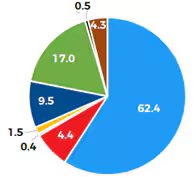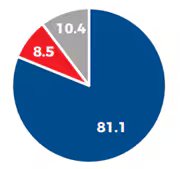Think of investing like balancing your diet; you need a mix of nutrition and taste. Similarly, investors often seek a balance between growth and stability.
That’s where a Hybrid Mutual Fund comes in. A Hybrid Fund combines equity and debt instruments within a single portfolio, aiming to offer both potential capital appreciation and relative stability. The equity portion focuses on long-term growth, while the debt portion helps manage volatility.
When investing through a Systematic Investment Plan (SIP), hybrid funds enable gradual market participation while benefiting from asset allocation. They maintain a balance between equity and debt as per the investment objective.
In this editorial, we discuss the top 3 Hybrid Funds in India based on their performance, asset allocation, consistency and will also discuss the risks.
#1 SBI Equity Hybrid Fund
The SBI Equity Hybrid Fund is among India’s oldest and most recognised hybrid schemes. It was launched on 9 October 1995 and was previously called the SBI Magnum Balanced Fund.
The fund aims to generate long-term capital appreciation with the flexibility of an open-ended scheme. It invests across equity, debt, and money market instruments to maintain a balance between growth and stability.
The scheme follows a diversified approach to investing, aiming to balance growth and stability through exposure to equities, debt instruments, and alternative assets.
Asset Allocation (%)
| Instruments | Minimum Allocation | Maximum Allocation |
| Equity & equity-related instruments (including derivatives) | 65% | 80% |
| Units issued by REITs / InvITs | 0% | 10% |
| Debt instruments and money market instruments (including securitised debt) | 20% | 35% |
Source: Scheme Information Document
As of 30 September 2025, the fund managed assets worth Rs 790.6 billion (bn). The portfolio shows a strong focus on equity (around 56.9%), while the remaining allocation is spread across debt, money market, REITs, and InvITs.
This helps balance potential returns from equities with the relative stability of fixed-income assets.
Portfolio Classification by Asset Class (%)

Source: Funds Factsheets
In terms of sectoral exposure, financial services form the largest chunk at 29.16%, followed by sovereign securities (10.58%), services (8.44%), and power (6.98%). Other sectors include consumer services, telecom, IT, and healthcare, reflecting a diversified spread across the economy.
The top equity holdings include HDFC Bank, Bharti Airtel, State Bank of India, and ICICI Bank, each contributing between 3–5% of total assets.
On the debt side, investments include Government of India securities and AAA/AA-rated bonds from institutions like LIC Housing Finance, PFC, and NABARD.
Over the past three years, the fund’s standard deviation stood at 8.72% and its Sharpe ratio at 0.86, indicating a balanced risk-return profile.
Scheme Performance Snapshot (5 Years)
| Scheme Name | Compounded Annualised Growth Rate (CAGR) | Current Value of ₹10,000 Investment |
| SBI Equity Hybrid Fund | 16.64% | ₹21596 |
| Scheme Benchmark: CRISIL Hybrid 35+65 – Aggressive Index | 15.21% | ₹20307 |
| Additional Benchmark: BSE Sensex TRI | 17.5% | ₹22407 |
Source: SBI Mutual Funds
#2 HDFC Balanced Advantage Fund
The HDFC Balanced Advantage Fund, an open-ended Balanced Advantage scheme, was launched on 1 February 1994. It evolved from the erstwhile HDFC Prudence Fund after its merger with HDFC Growth Fund, becoming the HDFC Balanced Advantage Fund.
The scheme seeks to offer long-term capital appreciation and income through a dynamic mix of equity and debt investments.
Asset Allocation (%)
| Instruments | Minimum Allocation | Maximum Allocation |
| Equity & equity-related instruments (including derivatives) | 65% | 80% |
| Units issued by REITs / InvITs | 0% | 10% |
| Debt instruments and money market instruments (including securitised debt) | 20% | 35% |
Source: Presentation (HDFC Balanced Advantage Fund)
The fund follows an active asset allocation strategy driven by a framework combining valuation indicators, macroeconomic trends, and stock-level opportunities.
As of 30 September 2025, the scheme maintained an unhedged equity exposure of 62.41% and a hedged equity exposure of 4.39%.
Portfolio Classification by Asset Class (%)

Source: Presentation (HDFC Balanced Advantage Fund)
Its debt portfolio comprises government securities (G-Secs), state development loans (SDLs), corporate bonds, and securitised debt instruments, with an average maturity of 7.65 years.
The equity portion is well diversified across market capitalisations, with 81.1% in large-cap stocks, 8.5% in mid-caps, and 10.4% in small-caps, strategically spread across sectors such as financials, industrials, and information technology.
Equity Portfolio Diversification Across Marketcaps

Source: Presentation (HDFC Balanced Advantage Fund)
This balanced approach enables the fund to capture equity market growth potential while mitigating volatility through its debt holdings and hedging positions.
If we look at the 3-year standard deviation of the funds, it’s around 13% and the 5-year is 9%. This reflects how risk moderates over time, supporting the fund’s long-term wealth creation potential.
Scheme Performance Snapshot (5 Years)
| Scheme Name | Compounded Annualised Growth Rate (CAGR) | Current Value of ₹10,000 Investment |
| HDFC Balanced Advantage Fund | 24.22% | ₹29,596 |
| Scheme Benchmark: # NIFTY 50 Hybrid Composite debt 50:50 Index (Total Returns Index) | 12.35% | ₹17,906 |
| Additional Benchmark: NIFTY 50 Total Returns Index (TRI) | 18.36% | ₹23,241 |
Source: Presentation (HDFC Balanced Advantage Fund)
#3 ICICI Prudential Multi Asset Fund
The ICICI Prudential Multi-Asset Fund is an open-ended scheme that aims to build wealth over the long term by investing across multiple asset classes such as equity, debt, commodities, and real estate-linked instruments.
The fund was launched on 31 October 2002. The primary objective of the scheme is to generate long-term capital appreciation by investing in a diversified mix of asset classes, which helps balance growth and stability.
The fund follows a multi-asset strategy, ensuring that at least 10% of its corpus remains invested in three or more asset classes at any given time.
It invests in equities, debt securities, Exchange Traded Commodity Derivatives (ETCDs) like gold and silver, REITs, InvITs, and preference shares.
Asset Allocation (%)

Source: Presentation (ICICI Prudential Multi-Asset Fund)
The fund also employs derivative strategies such as covered calls to manage downside risk and improve portfolio yield. This counter-cyclical approach enables the scheme to adjust allocations based on market valuations and macroeconomic trends.
In normal market conditions, the fund maintains gross equity levels between 65–75%, qualifying it for equity taxation benefits.
As of 30 September 2025, the fund reported a closing AUM of Rs 680 bn.
Its net equity level after derivative adjustments stood at 57.3%, while the broader portfolio allocation included equity (66.76%), debt holdings (24.47%), gold/silver ETFs and mutual fund units (5.72%), exchange traded commodity derivatives (5.25%), REITs & InvITs (1.39%) combined, and cash & cash equivalents (10.55%).
The fund’s equity exposure is spread across several sectors, including banks (11.55%), IT – software (5.12%), automobiles (4.13%), petroleum products (4.11%), pharmaceuticals & biotechnology (3.80%), and finance (3.52%).
Top stock holdings include ICICI Bank, Axis Bank, Infosys, L&T, and Maruti Suzuki, among others. This diversified allocation helps the fund balance cyclical and defensive exposures across the market.
The annualised Standard Deviation of the fund stands at 6.90% suggesting moderate variability, considering its diversified exposure across equity, debt, and commodities. This helps provide a balance between return potential and risk through diversified asset allocation.
Scheme Performance Snapshot (5 Years)
| Scheme Name | Compounded Annualised Growth Rate (CAGR) | Current Value of ₹10,000 Investment |
| ICICI Prudential Multi-Asset Fund | 24.88% | ₹30395.36 |
| Scheme Benchmark: Nifty 200 TRI (65%) + Nifty Composite Debt Index (25%) + Domestic Price of Gold (6%) + Domestic Price of Silver (1%) + iCOMDEX Composite Index (3%) | 16.28% | ₹21266.38 |
| Additional Benchmark: Nifty 50 TRI (Additional Benchmark) | 18.36% | ₹23241.41 |
Source: Presentation (ICICI Prudential Multi-Asset Fund)
Which Hybrid Mutual Fund is Best for SIP?
Each fund adopts a distinct strategy to balance equity and debt exposure, offering varying levels of diversification and volatility management.
However, always keep in mind that hybrid funds carry market, interest rate, and asset allocation risks, which may affect short-term returns.
The choice of fund should depend on individual risk tolerance, investment horizon, and financial objectives. And investors should consider all these things before making any investment decisions.
Disclaimer: This article is for information purposes only. It is not a stock recommendation and should not be treated as such. Learn more about our recommendation services here…
The website managers, its employee(s), and contributors/writers/authors of articles have or may have an outstanding buy or sell position or holding in the securities, options on securities or other related investments of issuers and/or companies discussed therein. The content of the articles and the interpretation of data are solely the personal views of the contributors/ writers/authors. Investors must make their own investment decisions based on their specific objectives, resources and only after consulting such independent advisors as may be necessary.


